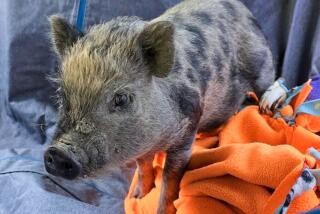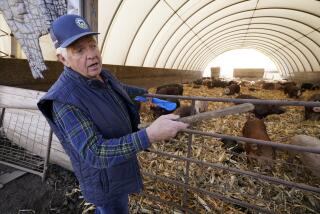This Little Piggy Stays Home : Pot-Bellied Pigs’ Novelty Has Worn Off, But Their Remaining Fans in the County Really Love Them
- Share via
First they were oddities imported for zoos.
Then they became the chinchillas of the ‘80s, a supposed way for breeders to get rich quick.
Hundreds were bought to breed novelty pets, some selling at five-digit prices. Thousands were sold, many to people amused by the idea of taking a miniature pig, its pot belly nearly dragging the ground, for a walk through the neighborhood.
But these are the ‘90s, and the gag has worn thin. Those who bought their pigs on a lark have discovered that although the piglets start out itsy-bitsy-cutesy, they turn into 100-pound bundles of shrewd intelligence that require only a glance to figure out how the pantry door opens.
Many of the breeders who ran what some called “piggy mills” have disappeared. Many of the faddists have been advertising their pigs for sale, sometimes even giving them away. Perhaps even . . . well, as one owner put it: “I was real concerned that, unlike dogs and cats, people would eat the pigs.”
Lorrie Boldrick, a veterinarian who specializes in miniature pot-bellied pigs, said there are more pigs around than one would guess. She sees an average of five a day at her practice in Orange, “so I’d say there are more than several hundred in Orange County alone.” One owners organization estimates there are 40,000 nationwide.
“A lot of these pigs get dumped and go to another home,” Boldrick said. “Maybe 30% of the pigs I see are in their second homes.”
But this development is not all bad, said Raena Barry of Moorpark, founder of the National Committee on Pot-Bellied Pigs. Culling the faddist from the ranks is purifying the corps of true pig devotees, she said. Also, no longer being a trendy pet has driven prices down to around $400 for a pet piglet, around $1,000 for a show-quality pig.
Pigs will be better cared for, she said, and eventually they will be swimming in the mainstream.
At present, 16 of 31 Orange County cities have passed ordinances permitting pot-bellied pigs in homes under varying conditions.
A 17th city, Huntington Beach, is expected to join the list on Monday, when the City Council votes on a pet pig ordinance requested by a local pig owner, Megan Oswald.
“I just want an ordinance so people who really want them can have them without it being against the law,” Oswald said in an interview.
Oswald’s request got a sympathetic response from the council. Councilman Don MacAllister called the pigs “the pet of the ‘90s” and said it was interesting that he had never heard a complaint about one in the city.
It’s not all that surprising, Oswald said after the meeting. “No one in our neighborhood except people we’ve talked to even know we have her. If these pigs cause any trouble, it’s for the owner, not the neighbors.”
“We talked to other cities, and no one’s had any problem with them,” said senior planner Mike Strange. “They’re a better pet than large, noisy dogs, and they’re less odorous.”
For such information, Strange has depended on a 155-page book co-written by Boldrick under her married name of Lorrie Blackburn. She said she wrote the book because people are demanding more information before buying a pet pig.
That’s encouraging, she said, because she regularly encounters people who want to dump their pet pig “from Day One.”
“I think sometimes they’re lied to by whoever wants to make the sale,” she said. “Sometimes they’re just naive about it. They think they’re going to stay as small as a piglet forever.”
Kiyoko Hancock in Pacifica, Calif., was one of the earliest breeders in the nation and now runs a registry for pot-bellied pigs. She gives all-day seminars aimed at making potential buyers understand what lies ahead.
“They’re not like a dog or cat,” she said. “They’re wild when they’re born. You have to pick them up, handle them, hand-raise them. They are a much more complicated animal.”
They’re extremely intelligent, perhaps the equivalent of a 3-year-old child, Hancock said. “But intelligence is a double-edged sword. People are thrilled they’re so smart, but it means they can learn something bad fast, too.
“People call me and tell me how cute it is that Little Louie can open the refrigerator. Maybe a week later, they call and complain they can’t keep Little Louie out of the refrigerator.
“They try taping the door, and he pulls off the tape. They put the food up higher, and he pushes up something he can stand on. He learns how to open every door in the house. I mean, they’re very smart.”
But the pigs are not marauders by nature, she said. Raised by a knowledgeable and attentive owner, they can be more like roommates than pets.
Oswald’s adolescent pig, 4-month-old Lily, is a little under 2 feet long. Her shoulders are only 10 inches off the floor. This tiny bundle weighs 13 pounds, about twice the weight of a dog the same size. She follows Oswald’s 7-year-old daughter nearly everywhere she goes in the house.
“I don’t really know why I like these animals so much,” Oswald said. “It’s just a fascination. I can’t explain it. I like their noses. It’s like they’re made out of rubber. I love the fact that they’re curious about everything.
“They don’t have a desire to please like a dog does, but they don’t have the fleas or the smell, either. They’re not all over you all the time; they’re pretty docile. And I like the sounds they make. They grunt and mumble a lot. They only squeal when they feel their life is in danger.
“And they live for food. It controls their lives completely.”
That’s a problem, Boldrick said. Her 4-year-old sow, Piggy Sue, is as tall as a medium-size dog and weighs 100 pounds--slim by pig standards. But most of the pigs she sees are “grossly obese,” she said. That’s because they’ll eat as much as they’re given, and they’re given plenty by some owners.
People love to feed pigs, she said. They love the expression of ecstasy on their faces: “They have smile muscles. It appears that they’re smiling.”
But pigs eat modestly and stay slim when fed properly, she said. A cup of porcine kibble twice a day costs $18 for eight weeks. Some fruits and vegetables each day supplement the diet.
The pigs are remarkably clean, Boldrick said. They can be housebroken in a week or less, sometimes in one day, and some have been reported to use cat boxes.
And while they can be remarkably agile when there’s good reason to be, they prefer a very leisurely pace, she said. “They like to do things with you--if it’s mutually agreeable. My pig retrieves. She may stop and drop it to check something out, but she’ll get around to bringing it to me.”
Boldrick said the appeal of the pigs may lie in the fact that the piglets, which can be held in one hand, are cute and cuddly, “and by the time they’re bigger, you love them.”
And people do love them.
Hancock publishes the Pig Tale Times, a bimonthly magazine of how-to articles and advice columns, the latest of which begins: “Oh, what fun it is to prepare your home for that new little sweetie pig.”
Hancock has also published a 23-page children’s book recounting the adventures of Arnold, the pot-bellied pig. She also sells a stuffed-toy pig of her own design.
And she has begun publishing a serial soap opera, “Moments in Time,” about Alison Davis and Paul Michaels, a tough San Francisco private eye, who in the first episode kisses Alison goodby and sets off to uncover who poisoned Arthur, her pot-bellied pig.
She does it all to cleanse the pig’s undeserved image.
“Pigs have always had a bad rap--not being clean, disposition problems. None of that is true,” she said.
Once the truth is out, she said, municipal zoning problems will disappear. “And you’re going to find out that there are a lot of latent pig people out there.”
Pot-Bellied Pets
Keeping a miniature pot-bellied pig at your home now is legal in most of Orange County’s cities. Check the list below for local restrictions.
City: Allow Pigs as Pets? Require License?
Anaheim Prohibited
Brea: Allowed; must obtain permit from city
Buena Park: Prohibited
Costa Mesa: Allowed; must obtain permit from animal control
Cypress: Prohibited
Fountain Valley: Prohibited
Fullerton: Allowed; must have 3,267 square feet of land area
Dana Point: Prohibited
Garden Grove: Prohibited
Huntington Beach: Prohibited but enabling ordinance comes before City Council Aug. 3.
Irvine: Allowed; must obtain livestock permit
Laguna Beach: Allowed; must obtain exotic animal permit
Laguna Hills: Allowed; housing zoned agricultural residential only
Laguna Niguel: Allowed
Lake Forest: Allowed; housing zoned for livestock only
La Habra: Prohibited
La Palma: Allowed; housing zoned agricultural residential only
Los Alamitos: Prohibited
Mission Viejo: Policy not yet determined
Newport Beach: Allowed; wild animal permit required
Orange: Prohibited
Placentia: Prohibited
San Clemente: Prohibited
San Juan Capistrano: Allowed; housing zoned for livestock only
Santa Ana: Allowed; cannot be within 100 feet of neighboring residence
Seal Beach: Allowed; must have an exotic animal permit
Stanton: Allowed
Tustin: Allowed; housing zoned agricultural residential only
Villa Park: Prohibited
Westminster: Prohibited
Yorba Linda: Allowed; in single-family housing if conditional-use permit is obtained
Orange County: Prohibited, except in areas zoned for livestock or if city states otherwise
Source: Individual cities
Researched by APRIL JACKSON
More to Read
Sign up for Essential California
The most important California stories and recommendations in your inbox every morning.
You may occasionally receive promotional content from the Los Angeles Times.













